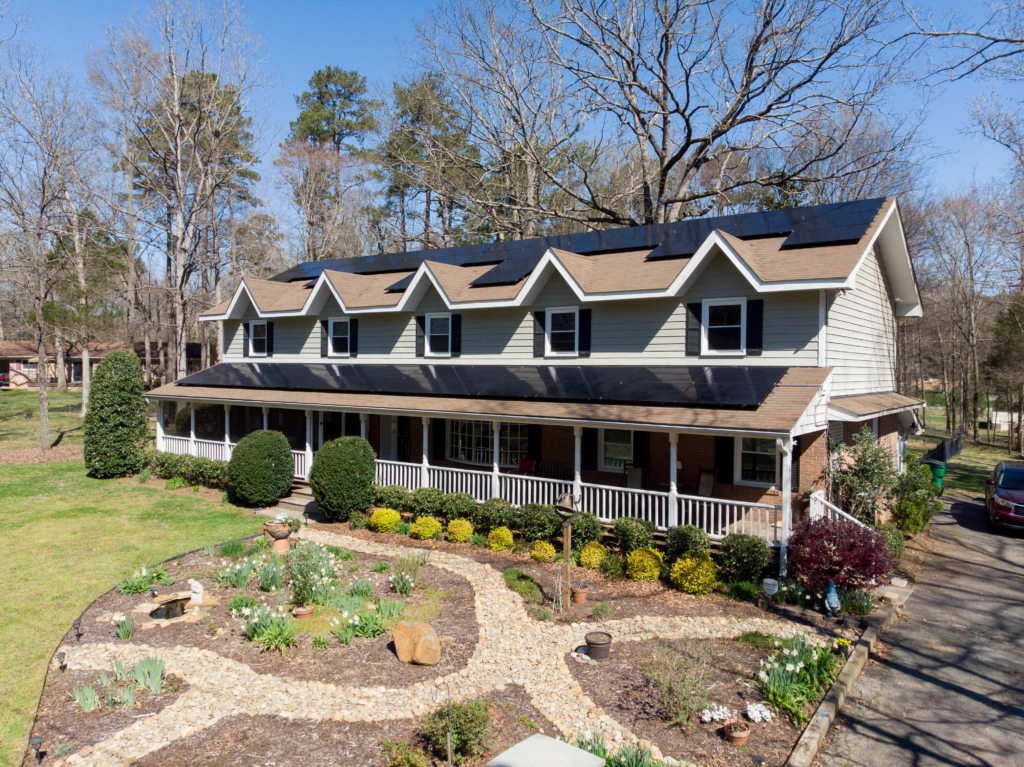John and Maisha’s Solar Story
John and Maisha’s Solar Story
John and Maisha’s solar story is just one of our favorites! John recently talked to us about how he and his wife Maisha decided to go solar. They live in Indian Land, SC.
![]()
In the beginning
It started when he was in college in Miami, FL. He recalls around 2003-2008 he became aware his family’s house in the Florida Keys was below sea level. The worst hurricanes on record hit 2004-2005, meanwhile gas prices reached all-time highs. John says he suddenly knew then something needed to be done to reduce our dependence on fossil fuels and improve our environment.
He began by starting a club called FIU Emerging Green Builders and was able to get a solar system donated for the group’s sustainable home project that won the Solar Decathlon in 2005 on the Washington D.C. National Mall. That kick-started his love of solar, which led both to career opportunities and to a project for his own home.
Solar on their first house
In 2015, John and his wife were starting a family and decided they needed more room! Putting his solar expertise to the test, John picked out a house with a southern exposure on the back in a neighborhood with a homeowners association (HOA.) At first the HOA told them no, but after educating the board with information from utilities, states and solar proponents, the board reversed its decision and John was able to sign a solar contract.
John believes that it’s because he was the first solar system installed in his neighborhood that it took his utility two months to approve his solar installation, and notes that now nowadays the process is much faster. His installation was completed in a single day, and right away he had a lot of pride – and even put a lawn sign which he remembers prompted some neighbors to ask about it and ultimately also install solar at their home. The most exciting part? Taking a selfie while switching his solar system on.
John’s perspective on solar: Now’s the best time
![]() Solar technology has been around for over 40 years, and today it’s wonderfully affordable. John says the that old adages apply: good things come to those who wait, if it takes a while then it must be worth it, better late than never.
Solar technology has been around for over 40 years, and today it’s wonderfully affordable. John says the that old adages apply: good things come to those who wait, if it takes a while then it must be worth it, better late than never.
Installations have got tighter and cleaner, and can be executed quickly – plus installers now offer product warranties and risk-free production guarantees. John says he thinks that’s why solar’s becoming mainstream. There’s still a lot that goes into a home solar project behind the scenes with permitting, paperwork, inspections and installation, but even those processes are getting so standardized – such that John’s rightly notes that the timeline from signing a contract to turning on a system can be as fast as a month.
The proof is on the electric bill
They used to feel annoyed, frustrated and worried about high bills, but no more. After four years with solar, John loves getting his E-bill from the power company. These statements regularly show he produced more power and he received – in other words a negative bill balance. Sometimes he and Maisha email the bill to each other saying, “We rock!”
Credit saved up during the day provides savings on night-time use for the Sheldons (and the actual surplus energy from daylight hours goes out to the grid to serve their neighbors.) During those times their home’s carbon footprint is zero – which is gratifying knowing they’re “doing their part, doing the right thing”.
What’s behind that peace of mind? John says it’s little things, like not worrying about the AC being on, or an LED light left on, or an appliance plugged in. When using his corded leaf blower, he’s more than willing to go ahead and do his neighbor’s yard too while he’s at it!
John is thankful his family has encouraged his passion for solar power. He tries to contain his enthusiasm when random people find out he has solar, trying not to go overboard and seem crazy, but he means it every time when he says, “I’m living my dream and it’s been one of the best decisions I’ve made.”
If you enjoyed John and Maisha’s solar story and think you could be our next success story, contact us today!

Frequently Asked Questions About Solar for Your Home:
How exactly does going solar and a solar system itself work?
How many solar panels do I need for my home?
Roof-size/available space: When we look at the size of your roof and the space available, we gather data that tell us the maximum number of solar panels your home or site can hold and we even consider shading. We use a software “Suneye” which takes a 360 picture of your roof and we use this photo to determine if your home is a good candidate for solar.
Energy Usage: When we determine energy usage we look at your past electrical bills from over the course of a year to make sure your system isn’t too big or too small.
Your Budget: We take your budget seriously and most importantly, we want you to be satisfied with our services. We take your feedback on how much you want to spend so that we can size your system appropriately.
What is solar net-metering?
Does Duke Energy offer net-metering?
Curious about the cost of a home solar system?
Ready to Own Your Own Energy?
Speak to Us Today!
